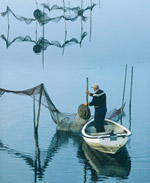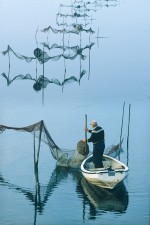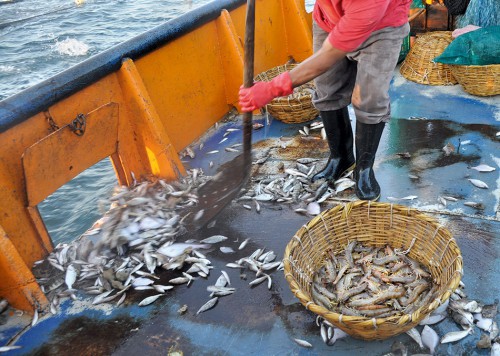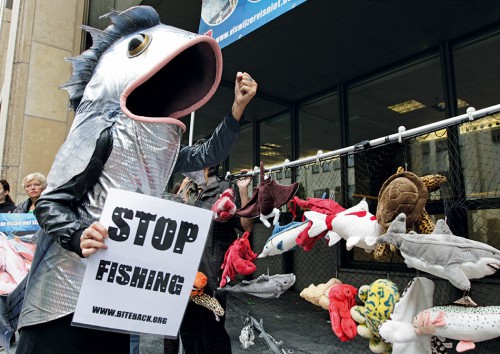
Turning the tide in fisheries policy?
High ambitions, clear goals
The EU’s fisheries policy has failed. Many fish stocks are overexploited. The fishing fleet is too large: there are too many boats out fishing, and not enough fish. For decades, catches have regularly exceeded the levels recommended by scientists. But this situation is about to change. The European Commission has resolved to overhaul the EU’s fisheries policy and management at long last. A reform of its Common Fisheries Policy (CFP) – the regulatory framework applicable to all the EU Member States – is scheduled for 2013 and aims to achieve the following goals:- In future, fish stocks in the EU will no longer be fished in accordance with the precautionary approach; instead, stocks must be exploited at levels that produce the “maximum sustainable yield” (MSY) (i.e. the amount that can be harvested with a view to protecting stocks).
- Fleet overcapacity is to be reduced.
- The amount of unwanted bycatch is to be reduced and discards eliminated.
- Fishing should not only exploit fish stocks sustainably, but should also have minimum impact on marine habitats, the aim being to ensure that fisheries management follows the ecosystem approach.
- There should be a stronger focus on regionalization. Fishermen in the various countries and regions should be involved to a greater extent in fisheries management, with Brussels merely establishing the general policy framework.
- Many of these goals have already been achieved in other countries. In Europe, however, a sustainable and economically efficient fishing industry is still far from being a reality. It has become apparent that in a union of states like the EU, reconciling highly diverse national interests is a difficult process. However, the mere fact that the European countries were able to agree on a Common Fisheries Policy in the first place should be viewed as a success in itself. The Treaty of Rome, which created the European Economic Community (EEC) – the precursor to the EU – in 1957, contained a commitment to the formulation of a common fisheries policy. In those days, however, the fisheries sector was still relatively small and industrial fishing fairly rare. Furthermore, the scope of European fisheries policy extended only to the 12 nautical mile zone then in force.
Much has changed since then. Firstly, as time went on, major fishing nations such as Denmark, the United Kingdom, Portugal and Spain joined the EEC. And secondly, the scope of application of European fisheries policy increased with the introduction of the exclusive economic zone (EEZ), which extends to a distance of 200 nautical miles out from the coastal baseline. As a result, individual Member States acquired exclusive rights to fish in much larger areas of the sea. A Common Fisheries Policy was first adopted in 1982, and was accompanied by the introduction of the quota system. Under this system, the EU sets a total allowable catch (TAC) for the various species of fish and then allocates a fishing quota (based on a percentage of the catch) to each fishing nation, calculated according to a specific formula.
Fewer vessels, more efficiency
Whereas Denmark and Germany have already substantially reduced their fishing fleets, the Dutch, Portuguese and Spanish fleets in particular are still too large. In regions such as Galicia, the fishing industry is still an important source of income, as very few jobs exist in other sectors. Politicians therefore shy away from any reduction in the fishing fleet, which is also heavily subsidized for structural policy reasons. In the structurally weak fishing regions, EU funding has been – and is still – accessed in order to put new fishing vessels into service or refurbish older ships. The welfare of the region as a whole thus takes precedence over the greater goal of sustainable fishing. But generous subsidies create a vicious circle for the fishing industry. Government loans for fleet development have to be repaid, which compels fishermen to fish intensively with no regard for the welfare of fish stocks. This is one of the reasons why the Fisheries Ministers, who form the Fisheries part of the EU’s Agriculture and Fisheries Council and are responsible for setting the new Total Allowable Catch (TAC) every year (in tonnes), have regularly set TACs which are far higher than recommended by fishery scientists – in extreme cases, up to 48 per cent higher.
Tradable quotas Tradable quotas are a fisheries management tool used by various countries around the world. In 1986, New Zealand became the first country to incorporate a tradable quota system into nation-al legislation. These tradable quotas are often known as „individual transferable quotas (ITQs)“.The term preferred by the EU is „transferable fishing concession“ (TFC).
- An oversized fishing fleet also makes fishing inefficient, as there are far too many vessels in pursuit of the available stocks. In order to achieve even approximate compliance with the fishing quotas, each individual vessel can only harvest a small percentage of the Total Allowable Catch. It would be more sensible to reduce the number of vessels in operation and utilize their capacity to the full. One possible solution for reducing overcapacity is to introduce tradable quotas – initially at country level and later EU-wide. Fishing companies could sell these individual transferable quotas (ITQs) to others at a profit. Less economically efficient companies would be inclined to sell, and more profitable companies would be likely to buy the ITQs. In this way, the industry gradually sheds the less profitable companies, and the number of fishing vessels is reduced. A system of catch quotas has already been introduced in Denmark. Here, in order to prevent the formation of monopolies and the bulk purchasing of quotas by a handful of fishing companies, no more than four vessels may be operated by a fishing company. The European Commission is proposing to subdivide ITQ trading according to vessel size (i.e. vessels longer than 12 metres, and vessels under 12 meters in length). Owners of smaller vessels would not be permitted to sell their quotas to owners of ships in the larger-vessel category. This measure is intended to protect artisanal coastal fishing using smaller boats.
-
 5.19 > Pot fishery: a form of artisanal fishing still practised in Denmark.
5.19 > Pot fishery: a form of artisanal fishing still practised in Denmark. Doing battle against discards
In its current draft of the new CFP, the European Commission also makes a number of proposals for dealing with the problem of discards. All over the world, millions of tonnes of freshly caught fish and marine fauna are dumped back in the sea every year. Most of the discards are already dead when they go back into the water. This practice is a massive waste of natural resources. What’s more, the discards are not systematically recorded, creating a large gap in the data that fishery scientists need to estimate the size of fish stocks accurately. In North Sea sole fishery, for example, large quantities of plaice and other flatfish, such as dab, are caught as bycatch. In some cases, this unwanted bycatch amounts to 70 per cent of the catch. As many plaice are too small to be landed legally and other flatfish are unpopular as eating fish, the bulk of this bycatch – with the exception of a few high-grade individuals – is dumped overboard. As the discards are not recorded, researchers find it almost impossible to make an accurate assessment of the status of flatfish stocks other than sole and plaice. There are various reasons why fish are discarded:- For some species, such as crustaceans, starfish and smaller fish such as the European eelpout and the family of gobies, there is simply no market.
- The fishermen sort out the high-grade components of the catch, such as the largest and heaviest individuals from a given species. The rest is dumped overboard. This high-grading has been prohibited in the EU since 2010 but is still practised.
- The fish are too young or too small. The rules currently in force prohibit the landing of these undersized fish.
- Fishermen are not permitted to land species for which they have not been allocated a quota. Nor can they land species for which their quota is already fulfilled. This problem occurs in mixed fisheries, where several species of a similar size occurring in a single habitat are sometimes netted together. A haddock fisherman, for example, is not permitted to land any cod caught as bycatch. Under the current rules, the cod must be discarded.
- Due to the rules currently in place under the existing CFP, this type of prohibition on landings means that discarding still takes place on a large scale within the EU. As one possible solution, the European Commission is proposing a reform of the old quota allocation system. At present, individual quotas are still allocated for many species, even though these species are only caught in mixed fisheries. In future, it would be possible or even obligatory to acquire additional bycatch quotas, for example for cod and haddock. These bycatch quotas would be allocated in a flexible and straightforward manner. For example, rather than automatically being allocated for an entire year, they could be assigned on an ongoing basis throughout the course of the fishing season, depending on the status and development of stocks. The aim is to encourage fishermen to avoid bycatch of unwanted species – for example, through the use of better and more selective fishing gear. If they failed to achieve an appropriate reduction in the amount of bycatch, they would be obliged to apply for a bycatch quota. A fisherman would then have to demonstrate that he had been allocated a separate quota for each species likely to occur in the fishing grounds. In a mixed fishery, his fishing activities would then be oriented towards the stock with the smallest population.
In the North Sea, for example, the haddock stock is in a good state but the status of cod is less favourable. At present, a fisherman can catch as much haddock as he needs to fulfil his quota. Inevitably, though, some cod are caught as bycatch in the net and must be discarded. If the fisherman had two quotas, he could land both haddock and cod. However, he would have to stop fishing – for both haddock and cod – as soon as he had met his cod quota. This is intended to protect cod from overfishing and avoid discards. Furthermore, the European Commission is keen to encourage the use of more selective fishing gear in future, as more sophisticated fishing technology can also help to reduce the amount of bycatch. A further proposal aims to reduce bycatch by obliging fishermen to avoid certain areas of the sea with large stocks of bycatch species at certain times of the year. A further possibility being discussed with a view to reducing discards is to equip the EU’s fishing vessels with electronic surveillance systems, including CCTV, in future. This would enable checks to be carried out to determine whether any fish had been discarded, and if so, of which species. More intensive deployment of observers is a further option. However, the advantage of CCTV, compared with observers, is that it is far less expensive.
- 5.20 > Discarding of bycatch is a problem worldwide, not just in the EU. This Mexican prawn fisherman is dumping fish with no market value overboard.

More power for fishermen
At present, the EU’s fisheries policy is still largely a top-down policy. The rules are agreed in Brussels at the highest level and must be adhered to by every fisherman in the same way. National or, indeed, regional approaches to fisheries management are virtually non-existent at present. As a result, conflicts are inevitable. Many of the sometimes contradictory rules agreed in Brussels are viewed by fishermen themselves as excessive or impractical. Indeed, some are ignored altogether. The Commission is proposing to defuse the situation by involving fishermen in fisheries management and decision-making to a greater extent, in the hope that this will increase their acceptance of the rules.
There is to be stronger regionalization of fisheries policy, as the Agriculture and Fisheries Council explains in its proposal on CFP reform. The proposal envisages that Member States would be able to devolve decision-making to the regional level. In recent years, a number of Regional Advisory Councils (RACs) have been established by various EU Member States, e. g. for the Baltic Sea and for the waters in the Arctic and around Iceland. These RACs have produced a number of proposals for CFP reform. Up to two-thirds of the members of the RACs are experts from the fisheries sector, with experts from other interest groups, such as nature conservation organizations and trade unions, comprising the remaining one-third. In future, the RACs, in conjunction with the relevant national authorities, could potentially undertake the management of fisheries in their specific region and submit their proposals to Brussels. Provided that there were no objections from the European Parliament or individual countries, the proposed fisheries management strategy would then enter into force.
Open-ended
Only time will tell which of the European Commission’s reform proposals will be implemented; that will become clear when the new CFP is adopted in 2013. Ultimately, it is up to the Council and the European Parliament to decide which of the Commission’s proposals will be incorporated as rules and provisions in the new CFP. We can only hope that the two institutions manage to agree on a fisheries policy which is good for both the economy and the environment. In fact, there is cause to be reasonably optimistic here: with the Marine Strategy Framework Directive, the European Union, in 2002, imposed an obligation on all Member States to take the necessary measures to protect and conserve the marine environment and achieve or maintain its good environmental status by the year 2020 at the latest. The Council is therefore obliged not only to ensure, with the new CFP, that fisheries are exploited at levels which produce the maximum sustainable yield (MSY); it must also minimize the impact of fishing on the marine environment at the same time.
